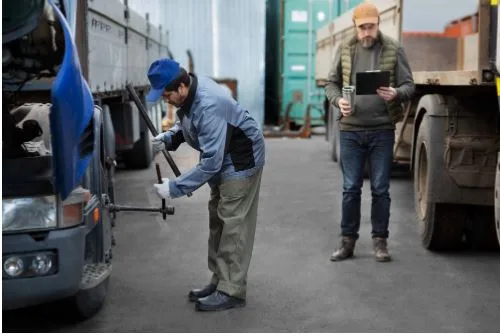Trucking Negligence: A National Safety and Economic Liability
A new analysis by Bader Law underscores how unsafe trucking practices are not only a public safety crisis but also a growing economic liability for the United States. The study reveals that negligence in the freight sector is driving up accident rates, legal costs, and insurance burdens at a time when the industry is expanding faster than ever.
The Scale of the Problem
The U.S. trucking industry is a powerhouse, moving more than 70% of all domestic freight and generating nearly $987 billion in 2024. With 13 million trucks registered nationwide and nearly 2 million companies operating freight vehicles, the sector is indispensable to commerce.
But the same study shows that this economic engine is also a source of escalating risk. In 2023, there were 170,716 truck-related crashes, resulting in 5,472 deaths and 86,842 injuries. That’s an average of 420 accidents every day. Since 1970, truck travel has surged by 231%, and fatalities involving large trucks have climbed from 2,983 in 2009 to 4,354 in 2023.
The data suggests that the rise in accidents is not simply a byproduct of more trucks on the road. Instead, negligence—both at the driver and company level—has emerged as a central factor.
Negligence as a Business Risk
The study highlights that 96% of truck-related fatalities are tied to preventable human error. These errors range from speeding and fatigue to falsified records and skipped maintenance.
- Speeding was linked to 32% of crashes.
- Hours-of-Service (HOS) violations accounted for more than 40% of driver-related inspection failures.
- In 2023, 58,918 drivers were cited for HOS violations, with nearly half involving driving beyond the 14-hour duty limit.
- Log falsification remains a persistent issue, with fines reaching up to $87,830 for a single carrier.
For companies, these violations translate into lawsuits, insurance hikes, and reputational damage. According to court docket data, major freight carriers such as Swift Transportation and Werner Enterprises have faced hundreds of personal injury lawsuits in recent years.
Inspection Data: A Warning Signal
Roadside inspections provide a window into the scale of noncompliance:
- 65,448 violations for ignoring traffic control devices.
- 61,267 violations for speeding 6–10 mph over the limit.
- 62,413 violations for failing to wear seat belts.
- 52,516 violations for operating without a valid commercial driver’s license.
- 42,379 violations for driving without a valid medical certificate.
By mid-2025, inspectors had already recorded 4.6 million driver violations from 11.6 million inspections, including nearly 1 million violations by drivers who were placed out of service.
These figures suggest that negligence is not an isolated problem but a systemic one, with widespread disregard for safety regulations across the industry.
Timing and Geography of Fatal Crashes
The study also examined when and where fatal truck crashes occur:
- 51% of deaths happened on major roads other than interstates.
- 34% occurred on interstates and freeways, while 15% took place on minor roads.
- Nearly half of all fatalities (47%) occurred between 6 a.m. and 3 p.m., a period when traffic is heaviest and commercial deliveries are most active.
This daytime concentration of crashes highlights how negligence intersects with peak economic activity, amplifying both human and financial costs.
Freight Type: Hazards Beyond the Highway
The type of cargo being hauled also plays a role in accident severity:
- Hazardous Materials (Hazmat): Over the past decade, hazmat-related truck crashes have increased by 155%, causing 52 deaths and 160 injuries. More than 90% of hazmat incidents involve repeat offenders, and 75% are linked to fatigue or inattention. Cleanup costs and environmental damage add another layer of liability.
- Oversized Loads: These require special permits and escorts, yet failures in compliance have led to catastrophic accidents, such as a 2023 Texas crash involving a 350,000-pound load that killed two people.
- Perishable Goods: Time-sensitive deliveries often pressure drivers to speed or exceed HOS limits, increasing fatigue-related risks.
Each freight type carries unique risks, but the common denominator remains negligence—whether through poor oversight, regulatory shortcuts, or unsafe driving practices.
The Economic Fallout
Negligence in trucking is not just a safety issue—it’s an economic one. The costs ripple across multiple fronts:
- Insurance premiums rise for companies with repeated violations.
- Legal settlements from personal injury and wrongful death lawsuits can reach millions.
- Supply chain disruptions occur when accidents block major routes or destroy cargo.
- Environmental cleanup costs from hazmat spills can stretch into the tens of millions.
The study suggests that without stronger enforcement and cultural change within the industry, these costs will continue to escalate, undermining the very economic benefits the trucking sector provides.
A Call for Accountability
The findings from Bader Law’s study point to a clear conclusion: negligence is not an unavoidable byproduct of trucking but a preventable crisis. Stronger penalties, stricter enforcement of HOS rules, and greater accountability for repeat offenders are essential steps toward reducing both fatalities and financial losses.
As the industry continues to grow, the question is not whether trucking will remain central to the U.S. economy—it will. The real issue is whether companies and regulators will act decisively to curb negligence before the costs, both human and financial, climb even higher.






